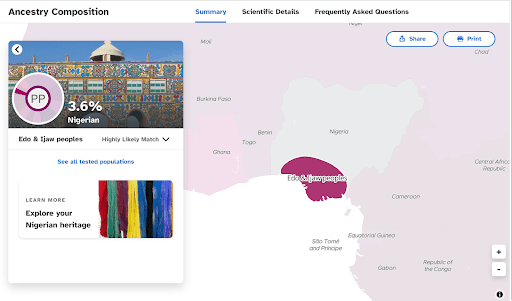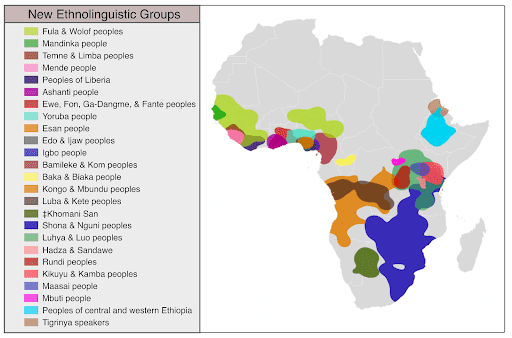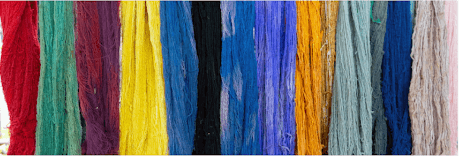23andMe’s latest update provides new ancestral connections to 25 African ethnolinguistic groups, including Ashanti ancestry, allowing people to explore connections with groups sharing common languages and cultures.
Along with the recent ancestor locations previously covered, this brings us to over 200 Ancestry Composition populations in Africa. This update is just one of many steps we’re taking to offer richer and more detailed information for customers with African ancestry. We are always looking to improve, and we hope to add even more granular ancestry results to our customers and better represent the depth of our genetic diversity.
What will customers find in this update?
With this update, some customers with African ancestry, including those with Ashanti ancestry, will discover new Ancestry Composition matches to one or more of 25 new genetic groups, often called reference populations, representing present-day ethnolinguistic groups in Sub-Saharan Africa. These new groups include the Igbo, Yoruba, Kongo, Mandinka, Shona, and Ashanti peoples. Customers will also find a map marking where the people in each reference population and their ancestors have lived for generations.
Customers who receive a match share some of their ancestors with that population within the last 250 to 300 years. And because of the populations’ roots in these areas for generations, those ancestors likely lived in the same location and shared their communities’ cultures. And in fact, the customer may have relatives who still live there today! Since cultural identity is so much more than DNA, though, keep in mind that these results alone do not say that a customer belongs to an ethnic group today.

Where are the new groups?
Some customers may now receive matches to genetic groups (reference populations) that reveal shared ancestors and connections with present-day ethnolinguistic groups, including Ashanti ancestry. The regions below depict where the people in 23andMe’s reference populations, such as the Ashanti people, and their ancestors have lived for generations.

Matches to these regions represent ancestors who may have lived anywhere from now to approximately 250-300 years ago. These represent modern-day and historically recent ethnolinguistic groups and their ancestral regions. Previous events, such as migration, war, and earlier decades of the transatlantic and intra-African slave trade, may have led to major movements and mixing of people, so a customer’s African ancestors from 400+ years ago may have lived in different regions.
How did we develop these ancestry insights?
Listening to our Black customers and broader communities, we heard clearly that people seek more specific connections beyond regions to people in Africa. These ties are often hard to discover, as few people of African descent in the Americas have genealogical records from before the Civil War (1861-1865), primarily due to the transatlantic and intercolonial slave trades.
Before now, 23andMe’s Ancestry Composition report revealed specific African countries and sub-country regions where evidence of a person’s recent ancestry is found. However, modern country connections, including these, often reflect how colonialism shaped borders within Africa and not how African people identified historically or prefer to identify today. We knew we needed to help people connect to their ancestry in additional ways to better reflect African people. So how did we do it?
- For many years, 23andMe has partnered with our community of research participants and other researchers to study genetic, language, and cultural group data from people in Africa and people with families from Africa. These efforts, including the Global Genetics Project and Populations Collaborations Program, first improved Sub-Saharan African ancestry insights in 2018.
- From 2019 to 2020, the 23andMe team worked with scholars of African history and African American studies to develop and publish one of the most comprehensive investigations of the transatlantic slave trade ever conducted.
- From this research, we identified 25 unique genetic groups of reference individuals in Africa.
- Using the information we previously collected on language, geographic location, and culture, we found that these genetic groups corresponded with particular ethnic groups and spoken languages.
- Finally, we developed an algorithm to determine if customers with African ancestry have shared ancestry with these groups.
Now, thanks to our collaborators and community of research participants, we can provide our customers with more meaningful information about their connections to people and places in Africa. With the addition of these new ethnolinguistic groups, we now offer insights to over 200 African regions. And as our database expands and analyses improve, we will continue providing new insights like this to better represent our genetic diversity.

Updated List of Populations in Sub-Saharan Africa
African Hunter-Gatherer
- Mbuti people — NEW
- Baka & Biaka people — NEW
Congolese & Southern East African
-
- Angolan & Congolese
- Congo (the Democratic Republic of the)
- Shona & Nguni peoples — NEW
- Luba & Kete peoples — NEW
- Kongo & Mbundu peoples — NEW
- Angolan & Congolese
Southern East African
- Kenya (2+ regions)
- Rwanda (3+ regions)
- Kikuyu & Kamba peoples — NEW
- Luhya & Luo peoples — NEW
- Maasai people — NEW
- Rundi peoples — NEW
- Hadza & Sandawe — NEW
- Broadly Congolese & Southern East African
West African
- Ashanti Ancestry in Ghana, Liberia & Sierra Leone
- Ghana (7+ regions)
- Liberia (6+ regions)
- Sierra Leone
- Ashanti people — NEW
- Ewe, Fon, Ga-Dangme, & Fante peoples — NEW
- Mende people — NEW
- Temne & Limba peoples — NEW
- Peoples of Liberia — NEW
- Senegambian & Guinean
- Guinea (3+ regions)
- Cape Verde (7+ regions)
- Gambia
- Senegal
- Mandinka people — NEW
- Fula & Wolof peoples — NEW
- Nigerian
- Nigeria (18+ regions)
- Edo & Ijaw peoples — NEW
- Igbo people — NEW
- Yoruba people — NEW
- Esan people — NEW
- Bamileke & Kom peoples — NEW
- Broadly West African
- Cameroon (3+ regions)
- Mauritania
Northern East African
- Ethiopian & Eritrean
- Ethiopia (6+ regions)
- Eritrea (4+ regions)
- Peoples of central and western Ethiopia — NEW
- Tigrinya speakers — NEW
- Somali (9+ regions)
- Sudanese
- Sudan (7+ regions)
- South Sudan
- Broadly Northern East African
- Broadly Sub-Saharan African
- ‡Khomani San — NEW
Most common ethnolinguistic group connections among 23andMe customers
Of 23andMe customers who receive a match to a new group, the most common matches are with the Igbo and Kongo and Mbundu people. Both of these groups are matches for around 30 percent of customers. The next most common group is the Fula and Wolof people, who match around 13 percent of customers.
These proportions likely reflect the impact of the transatlantic slave trade in which the majority of the 12.5 million enslaved Africans were taken from ethnolinguistic groups residing in the mid to southern Atlantic coast of Africa and forced into the Americas. Each of the remaining ethnolinguistic groups is a match for fewer than 5 percent of customers.





